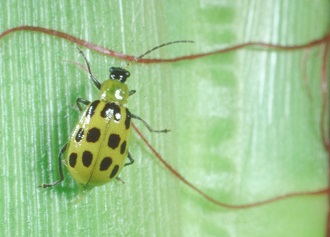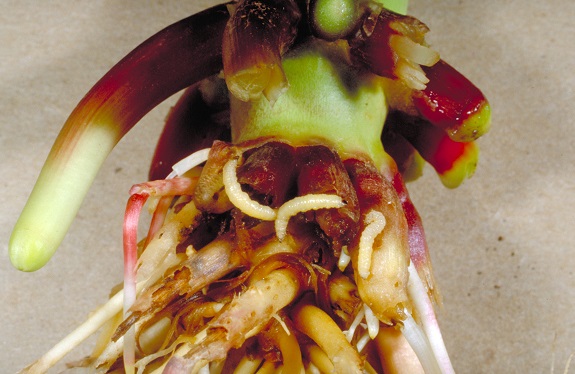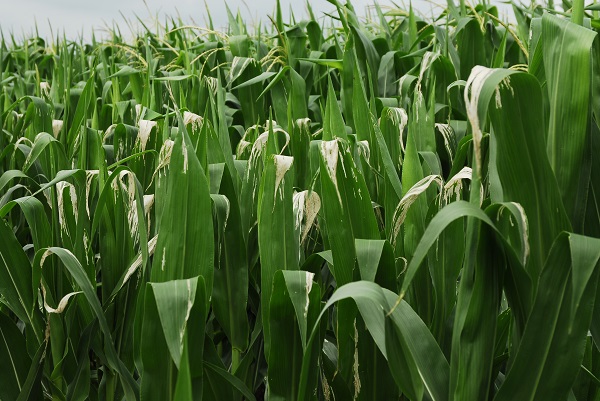Corn Rootworms in Kentucky
ENTFACT-152: Corn Rootworms in Kentucky | Download PDF
by Ric Bessin, Extension Specialist
University of Kentucky College of Agriculture
Throughout the US corn belt, the number one group of insect pests are the corn rootworm beetles. There are actually three species of corn rootworms in Kentucky, the northern, western and southern corn rootworms. While they each damage corn in a similar way, by chewing on the roots of the developing plant, they have some distinct differences in there biology and management.

Figure 1. Western corn rootworm adult.
The adult of each of the three species is a small green beetle about ¼-inch in size. The western corn rootworm is the most common species attacking corn in Kentucky and can be recognized by the three distinct black stripes on its pale green body. The southern corn rootworm (also known as the spotted cucumber beetle) is more common than the western, but is only an occasional pest of corn. The southern corn rootworm is recognized by the 11 prominent black spots on the green wing covers. The least common of the species in Kentucky is the northern corn rootworm which is lacking in any black markings on the wing covers.

Figure 2. Southern corn rootworm adult.
Biology
What is common with each of the corn rootworms in Kentucky is that their eggs hatch in late spring and the larvae are destructive to corn roots. Generally the majority of damage occurs during the month of June. What can differ among the species is when the eggs are laid. With the western and northern species the eggs are laid in the soil at the base of corn plants during the previous summer. These species have a very narrow host range, feeding on corn and a few other grass species. The eggs overwinter to hatch the following May. The young larvae can only move a very short distance in the soil to find roots and begin their development. For this reason, in Kentucky the western and northern corn rootworms are only problematic in continuous corn. The southern corn rootworm overwinters as an adult and will lay its eggs in the spring. The southern corn rootworm has a very wide host range and will lay its eggs around the bases on many plant species, it generally does not concentrate on just corn.

Figure 3. Corn rootworm damage to primary roots.
Damage
The damage done by the larvae to corn roots can be extensive. Corn plants develop roots on progressive rings, the corn rootworm larvae can destroy three or more complete rings of roots during June if populations are severe. Corn plants that have been heavily damaged by corn rootworm larvae often fall over partially and may attempt to bend upward. This is characteristic of rootworm damage and is termed ‘goose-necking’ of corn. Damaged roots will often develop a proliferation of secondary roots and may shown signs of drought stress even during periods of adequate soil moisture.
The adults emerge in July and can damage corn later in the summer. The adults feed on the upper surface of leaves, often concentrating damage near the leaf tips. Damaged on leaves appears brown where the lower surface of the leaf is left behind. The adults will feed on the silks if they are present. Prior to pollen shed, they have the potential to interfere with pollination if their numbers are high.

Figure 4. Leaf tip damage caused by corn rootworm adults.
'Soybean Variant' of the Western
In the states to our north, there is a biotype or variant of the western corn rootworm. With this variant, a large portion of the adult population leaves corn fields to feed on the leaves of soybeans and to a lesser extent other crops. They lay their eggs in the soil at the base of the soybean plants as well. The result is that when this soybean field is planted to corn the following year, there can be a threat of western corn rootworm damage in the first year corn. Fortunately, we have not had any reports of this variant in Kentucky. While the variant has spread considerably to the east and northeast from the areas it was first reported, movement southward has been slow. If the soybean variant were to reach Kentucky, it would dramatically affect the management of corn rootworms.
Management
Traditionally it has been the western corn rootworm that has caused most of the economic damage to corn in Kentucky. Only a very small percentage of damage has been associated with the northern or southern rootworms. Since the western corn rootworm is only a pest of continuous corn in Kentucky, the most effective and economically tool for its control has been crop rotation. Experience has shown us that in many situations it may take two to four years of continuous corn in a field to build an economic population of westerns. Risk of rootworm damage by keeping a field in corn for two consecutive years is relatively low. However, with more years that the field is kept in continuous corn the rootworm risk progressively increases. The northern corn rootworm is also controlled effectively in Kentucky with crop rotation.
As the southern corn rootworm lays its eggs in the spring, it can be a pest of first year corn. However, while problems in corn are not unheard of, economic losses from this species in Kentucky are rare.
Other than crop rotation, there are other effective treatments for corn rootworm including seed treatments, soil insecticides (liquid or granular), and Bt corn options. In Kentucky, consistent results have been shown with each of these strategies. When selecting among these strategies, growers should also consider what other pests they may need protection from, as some of these treatments can target multiple pests.
Issued: 11/19
CAUTION! Pesticide recommendations in this publication are registered for use in Kentucky, USA ONLY! The use of some products may not be legal in your state or country. Please check with your local county agent or regulatory official before using any pesticide mentioned in this publication.
Of course, ALWAYS READ AND FOLLOW LABEL DIRECTIONS FOR SAFE USE OF ANY PESTICIDE!
Images: Ric Bessin, University of Kentucky Entomology
